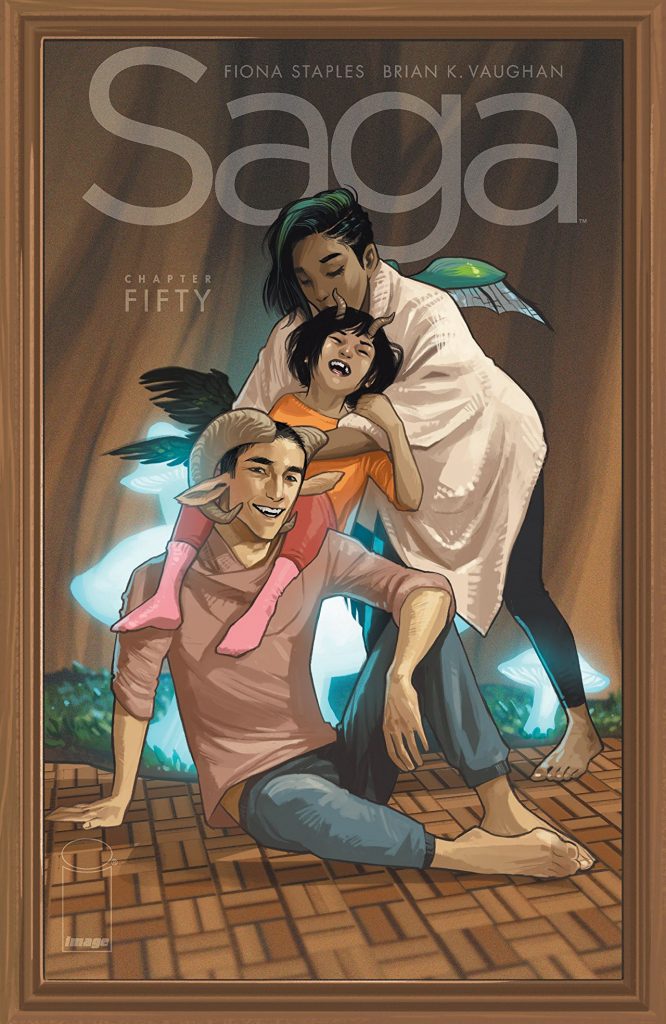Saga #50
Brian K. Vaughan (Writer), Fiona Staples (Artist), Fonografiks (letterer & designer)
Image Comics
March 28, 2018
Saga #50 lacks the bizarre fanfare that I was expecting in its monumental fiftieth issue, particularly for a comic that has frequented in endless plot twists, heartbreaking losses, bold sex scenes, and outlandish (quite literally) characters, both lovable and evil. What it does offer, however, is much better and much more necessary than I anticipated. It’s a reminder of what grounds this epic space opera in reality—maintaining one’s identity, family, and commitment to compassion and peace in a universe plagued by racial hierarchy, capitalist consumption, and endless war.
Although not boring by any means, Saga #50 takes a brief step back from the relative intensity of the series and reminds readers that family—both biological and otherwise—and love are at the heart of this comic. The comic conveys this message to the reader sometimes through a subtle nudge and at other times through a hard push.
The issue opens with a beautiful and brilliant sex scene, not uncommon for Saga’s opening pages. Marko orally pleasures Alana, their bodies in the ocean under two bright moons hanging in the purple and blue sky. The next page is a dazing mixture of limbs in a rare three-by-three grid, each row punctuated by Alana’s exclamations of “Yes.” This climactic moment comes to a humorous halt when she ejaculates on his face, terrified that she’s peed on him. However, the romance is soon rekindled when they reminisce about Marko’s marriage proposal seven years earlier, reminding the reader the amount of time the series has covered in its fifty issues. In these opening pages, Staples and Vaughn capture not only the span of Alana and Marko’s love but also its capaciousness, the way they move from sexy to laughing to gentle and back; it conveys the fullness of their love for each other, the catalyst and foundation of the entire series.
I spend time with this opening scene not for the sake of shock value (Saga readers are not easily shocked, I know). Rather, I think it is characteristic of Saga at its best and most recognizable. Fiona Staples’ artwork brings another otherworldly, spectacular planet to life and sets an ethereal backdrop for Brian K. Vaughan’s script in these pages. Vaughan balances the bold sex scene with saccharine, romantic reminiscing, and interrupts both with perfectly timed humor.
In addition to the love between Alana and Marko, this issue also touches on other familial bonds in the series. We find Sir Robot, the robot formerly known as Prince IV, broadcasting his knowledge of Wreath and Landfall’s collaboration to use weapons of mass destruction against the comet Phang with the journalists Upsher and Doff. In sharing this information, Sir Robot has been promised a spot in the Hebdomadal source protection program for himself, his son, Squire, and his partner, Petrichor. Their protection comes at the cost of their bodies, however, as they will be given a spell that will transform their entire body. This transformation carries a particular importance for Petrichor, a trans woman. When Hazel precociously questions her decision to stay with Sir Robot on Jetsam and alter her body, Petrichor responds, “I’m staying here on Jetsam because . . . because the universe is complicated, and I don’t owe you any explanation more than that,” in a powerful and particularly salient moment.
It’s these brief, subtle moments when Petrichor corrects Hazel, and perhaps some readers, or when Squire makes the most innocent and cutting statement about the way the adults around him are always on the run, that got to me as a reader and got to the heart of Saga’s brilliance, its honest, biting, beautiful meditation on identity, family, and human relationships.
In typical fashion, Saga leaves readers on a cliff hanger with the taunting “To Be Continued . . .” Yet in its fiftieth issue, that phrase seems to be a mark of pride and an emblem of success. Issue #50 took some time to breathe and bask in the luxury of its characters, their struggles, their joys, and their relationships, yet it still managed to move the plot forward and leave me eager for the next issue.
I came into Saga #50 expecting a self-conscious spectacle celebrating its fiftieth issue. What I got instead was a gentle reminder of just how and why Saga has been so successful for fifty issues: its heart. It grapples with complex human relationships and the love, and sometimes hatred, that fuels them. Ultimately, it reminds readers that the struggles of Alana, Marko, and Hazel—experiencing hatred and oppression for one’s identity and one’s family, losing loved ones and children, constantly fleeing danger, and struggling to find peace in a violent world—are not so distant, despite the spectacular universe in which this space opera is set.


